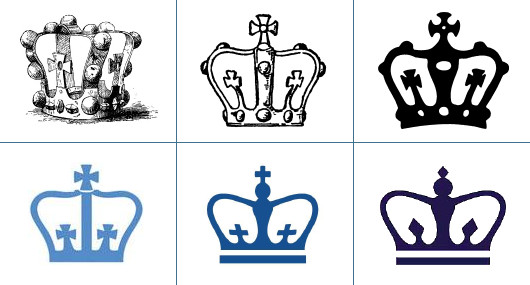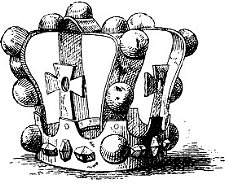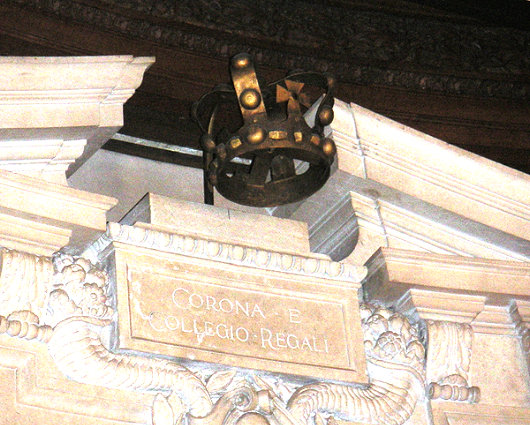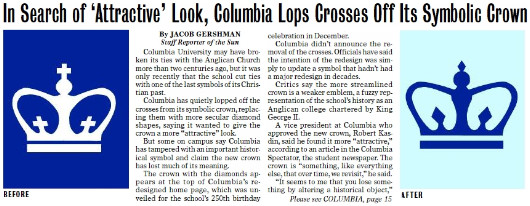
About Andrew Cusack
 Writer, web designer, etc.; born in New York; educated in Argentina, Scotland, and South Africa; now based in London.
Writer, web designer, etc.; born in New York; educated in Argentina, Scotland, and South Africa; now based in London. read more
News
Blogs
Reviews & Periodicals
Arts & Design
World
France
Mitteleuropa
Knickerbockers
Argentina
The Levant
Africa
Cape of Good Hope
Netherlands
Scandinavia
Québec
India
Muscovy
Germany
Academica
Crosses Return to Columbia Crown

 AFTER AN ABSENCE of some years, Columbia University has returned the crosses to its official crown emblem. The crosses had been missing since March 2004, when they were replaced with trapezoidal lozenges, but the more historic cross design has quietly returned to favour as the Ivy League institution’s official symbol. Columbia was founded in 1784, but claims the earlier heritage of King’s College, founded in 1754 but exiled to Nova Scotia, where it now has university status, after the tumult of the American Revolution. A copper crown (right) was originally attached to the cupola of College Hall, King’s College’s home in the colonial city of New York. When Columbia was founded in 1784, a year after New York’s independence was recognized, the state legislature gave the property and endowment of King’s College to the new Columbia College, which was organized by the remaining non-Loyalist members of King’s College.
AFTER AN ABSENCE of some years, Columbia University has returned the crosses to its official crown emblem. The crosses had been missing since March 2004, when they were replaced with trapezoidal lozenges, but the more historic cross design has quietly returned to favour as the Ivy League institution’s official symbol. Columbia was founded in 1784, but claims the earlier heritage of King’s College, founded in 1754 but exiled to Nova Scotia, where it now has university status, after the tumult of the American Revolution. A copper crown (right) was originally attached to the cupola of College Hall, King’s College’s home in the colonial city of New York. When Columbia was founded in 1784, a year after New York’s independence was recognized, the state legislature gave the property and endowment of King’s College to the new Columbia College, which was organized by the remaining non-Loyalist members of King’s College.

Despite moving premises, Columbia kept the original copper crown. Prof. John McVickar exhibited the crown in 1820 to Stratford Canning, His Britannic Majesty’s Minister-Plenipotentiary to the United States, who quipped to the Columbia profesor: “You should preserve that crown carefully, sir, for you republicans will by-and-by need a crown.” That copper crown now rests above the fireplace in the Trustees Room of Columbia’s Low Library, atop the portrait of the first head of King’s College, the Rev. Dr. Samuel Johnson.

The removal of the crosses in 2004 was criticised by some as an act of political correctness and a disingenuous denial of the school’s claimed foundation in the Anglican King’s College of 1754.

But the be-cruxed crown once again graces the official documents and websites of “Columbia University in the City of New York”, as it has officially been called since 1896.

Officially, there are four different versions of the Columbia crown now used. They are (from left to right), the official university crown, the lozenge variant, the Columbia College crown, and the School of Engineering & Applied Sciences emblem.
Search
Instagram: @andcusack
Click here for my Instagram photos.Most Recent Posts
- Silver Jubilee November 21, 2024
- Articles of Note: 11 November 2024 November 11, 2024
- Why do you read? November 5, 2024
- India November 4, 2024
- The Lithe Efficiency of the Old Constitution November 4, 2024
Most Recent Comments
Book Wishlist
Monthly Archives
Categories



Well I have actually been in the trustees room and neglected to notice the crown. However if I ever have the opportunity again I will be sure to take note. PS didn’t notice the missing crowns from the symbol either. I have scrutinized my business card but since the crown on it is so small it is hard to tell if they are crosses or not.
As an alumnus, I am delighted to see the return of the proper crown with cross. Although secular, Columbia has always been more or less Episcopalian. St George’s Chapel was Anglican, and across the street sits the huge and magnificent seat of the Bishop of New York, the Cathedral of St John the Divine.
Having once swanned around the Upper West Side with great friends who were also parishoners of St John the Divine as well as a grad students at Columbia, I am so pleased about this particular Restoration.
Harvard has not followed suit–originally “Veritas” was followed by “pro Christo et Ecclesiae”. One of our friends wryly remarked that, having got rid of Christ and His Church, when would they drop “Truth”?
The Columbia University Marching Band [CUMB] oft noted for their sarcasm always kept the crosses on their seal. In fact, when visiting my friend (a Columbia University student,) upon pointing out the change in the campus wide symbol, they were shocked. (CUMB members may be secularized, but they love tradition.) And incidentally, after Columbia had a terrible loosing streak in the 80s, the Marching Band started beginning [American] Football games with–don’t tell the ACLU–a prayer.
Dear Mr. Cusack:
First, I would like to congratulate you on the elegance of your writings and your breadth of subjects. I first was referred to your website because I am trying to write a book about La Salle Military Academy from which I graduated in 1953. It was unceremoniously closed and I thought it should be celebrated. You wrote an excellent piece about it in 2006 and I have a link to it on my “favorites.”
I grew up on the Lower East Side of New York in a cold water flat that was demolished by Robert Moses to build the Al Smith project. I was able to date the builldong to 1811 in a reverse directory at the new York Historical Societyin assembling a book, “Life on the Lower east Side (Princeton Arch Press 2006) co-authored with Rebecca Lepkoff, now 92, who contributed 170 vintage photographs of the neighborhood from the 1930s and 1940s. The connection here is with your delightful article on Governor’s Island which I visited many times with my Uncle Pete who worked there as a fireman during World War II. By the way, you might be interested in highlighting the plaque the DAR placed in 1889 on the Brookln Bridge stanchion commemorating the site where Washington lived after being inaugurated. It’s in disrepair and fenced off.
The third connection is with this article. Rowman and Littlefield just published my book “Christians in the Movies: A Century of Saints and Sinners which looks at the portrayal of Christians in 200 films from 1905 through 2008. In it, I lamented the removal of the crosses from Columbia’s crest (i have my M.D.from there). I was glad to learn that they are back.
Is there somewhere that I can buy a compendium of your work rather than reading it off the web.
best,
Peter E. Dans
I’m not a Columbia alumnus but have always appreciated its Anglican heritage. In the late-nineteenth century New York Episcopalians were inspired by the vision of creating a “city on the hill” in Morningside Heights, dominated by three great church-related institutions — Columbia College, St. Luke’s Hospital, and the Cathedral of St. John the Divine — and sering the spiritual, corporeal, and intellectual needs of all New Yorkers. The removal of the crosses from the Columbia crown was a denial of both history and the aspirations of the great churchmen who built the wonderful “city” we all enjoy.
Yikes, someone didn’t do his homework. Columbia University was founded in 1754. King’s College was resuscitated as Columbia University by the new state of New York and a board of trustees made up of King’s College alumni including Alexander Hamilton and John Jay. Columbia’s charter and King’s College’s charter are one and the same so the institutions are legally, historically, and colloquially the same entity. On a separate note, I stumbled across this page and have been reading some of Andrew Cusack’s articles. I find it very odd how this Andrew fellow thinks he has the pedigree to justify the snobby satire he produces (even if it is only satire). He neither attended an Ivy League school not Oxbridge. St. Andrew’s is basically a school where B students from the United States attend when they can’t get into a top institution. It would be on par with an NYU or a Wake Forest if it were operating in the U.S.
I shall have to start explaining to people that I went to the “Wake Forest of Scotland”.
(Actually, that sounds like a lovely place to go for an autumnal stroll.)
Veritas, you’re an idiot.
I know nothing of the estimable Andrew Cusack’s background (beyond what he himself tells all his readers) but it is in fact immaterial here. The great Peter Simple (Michael Wharton) was grammar school educated but got to the core of the English class system with every satiric glance in its direction he ever put to paper.
Your vision of NYU and Wake Forest College being somehow equivalent is laughable. NYU has no social standing while Wake Forest is one of the “Hidden Ivies”. A young relation of mine, from a family which has been in the New York Social Register for many decades, and who attended, like his father and grandfather before him, one of the most socially prestigious of the New England prep schools, is a student there now.
You seem not to understand that lofty social class and grade-grubbing are mutually exclusive. Relevant too is the fact that Yale, Harvard and Princeton are now the abode of the painfully politically correct and are therefore avoided by the more traditional and discriminating members of the old families.
But you wouldn’t know about that would you?